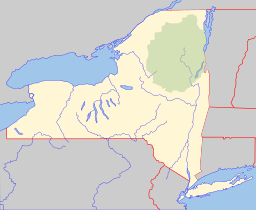| Seneca Lake | |
|---|---|
 Aerial view from the southern part of Seneca Lake. | |
| Location | Schuyler, Seneca, Yates, and Ontario counties, New York, United States |
| Group | Finger Lakes |
| Coordinates | 42°39′20″N 76°53′51″W / 42.65556°N 76.89750°W |
| Type | Ground moraine |
| Primary inflows | Catharine Creek, Keuka Lake Outlet, underwater sources |
| Primary outflows | Seneca River/ Cayuga-Seneca Canal |
| Basin countries | United States |
| Max. length | 38 mi (61 km) |
| Surface area | 66.9 sq mi (173 km2) |
| Average depth | 292 ft (89 m) |
| Max. depth | 618 ft (188 m) |
| Water volume | 3.81 cu mi (15.9 km3) |
| Shore length1 | 75.4 miles (121.3 km) |
| Surface elevation | 446 ft (136 m) |
| Settlements | Watkins Glen, Geneva |
| 1 Shore length is not a well-defined measure. | |
Seneca Lake is the largest of the glacial Finger Lakes of the U.S. state of New York, and the deepest glacial lake entirely within the state. It is promoted as the lake trout capital of the world, and is host of the National Lake Trout Derby. Because of its depth and relative ease of access, the US Navy uses Seneca Lake to perform test and evaluation of equipment ranging from single element transducers to complex sonar arrays and systems.[1] The lake takes its name from the Seneca nation of Native Americans. At the north end of Seneca Lake is the city of Geneva, New York, home of Hobart and William Smith Colleges and the New York State Agricultural Experiment Station, a division of Cornell University. At the south end of the lake is the village of Watkins Glen, New York, famed for auto racing (hosting Watkins Glen International racetrack) and waterfalls.
Due to Seneca Lake's unique macroclimate it is home to over 50 wineries, many of them farm wineries and is the location of the Seneca Lake AVA. (See Seneca Lake wine trail).
- ^ "Home - Seneca Lake". Archived from the original on 27 March 2012. Retrieved 3 April 2012.

